|
Four Periods in the History of Bolivia The history of Bolivia can be divided into four major periods or eras: Ancient History, the Colonial Era, the Post Colonial Era, and Recent History.
Bolivia is one of the most culturally diverse countries in South America, with over 30 native indigenous groups, a large mestizo population, and a growing foreign immigrant population, all of whom have contributed to shape Bolivian culture. However, this diversity has also made it very difficult to form a stable government. The economy in Bolivia is highly dependent upon exports and conflicting interests between the country's many social and ethnic groups.
Bolivian geography has changed dramatically throughout the country's history as it has suffered several territorial losses during conflicts with neighboring nations. It's rugged topography makes both domestic and international interconnection difficult, and there are many other reasons Bolivia has been unable to maintain social, political and economic cohesion. This section on the history of Bolivia is divided into four main periods or eras to make understanding the country's historical timeline easy. They should be read in this order:
Ancient History (through 1499 A.D.)A brief description of what is known about the cultures that inhabited the region now known as Bolivia prior to the arrival of the Spaniards.
Colonial Era (1500-1800 A.D.)Spanish conquest, enslavement, assimilation and evangelization of the indigenous populations of the region. Their development of the mining industry upon which the economy in Bolivia has depended ever since.
Post-Colonial Era (1800-1900 A.D.)Discontent among the indigenous and mestizo population leads to revolts and the wars for independence along with the consequent division of territories into what are known as Bolivia, Peru, and Chile today.
Recent History (1900 - Today)The Republic of Bolivia (now called the Plurinational State of Bolivia) and its struggle to maintain social cohesion, political and economic stability, and development efforts being made through the present.
In addition Bolivia has nine states called departments. Read about each one here:Cochabamba Beni Santa Cruz Tarija     |
